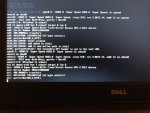Hello,
I bought three ssd to usb adapters (https://www.aliexpress.com/item/33034187646.html?spm=a2g0s.9042311.0.0.6cb04c4doK8A5N)
Before I will open dispute I would like to verify here with you if this is really problem of those adapters.
I have three SSD's connected to true nas PC in RAID. But I had to change connections. As replacement I choice Kebidu sata adapter mentioned above.
But when I try connect them to PC I can always see only one in time. I tryed to disconnect them and then connect one by one.
Strange is then one is connected and I connect another - the old is replaced by new. So I cant re-init RAID I have.
My guess it the problem is comming from same Serial number. Can serial number be generated by adapter by the way?
If I use for connect second disk another adapter (the old one), Raid is init (but ony with 2 disks, one is missing).
on the picture you can see what happend when I tryied to plug-in two disksk - maybe it say something.
Is there a way how mount disks in true nas with same serial number or the problem is somewhere else?
Thanks in advance
I bought three ssd to usb adapters (https://www.aliexpress.com/item/33034187646.html?spm=a2g0s.9042311.0.0.6cb04c4doK8A5N)
Before I will open dispute I would like to verify here with you if this is really problem of those adapters.
I have three SSD's connected to true nas PC in RAID. But I had to change connections. As replacement I choice Kebidu sata adapter mentioned above.
But when I try connect them to PC I can always see only one in time. I tryed to disconnect them and then connect one by one.
Strange is then one is connected and I connect another - the old is replaced by new. So I cant re-init RAID I have.
My guess it the problem is comming from same Serial number. Can serial number be generated by adapter by the way?
If I use for connect second disk another adapter (the old one), Raid is init (but ony with 2 disks, one is missing).
on the picture you can see what happend when I tryied to plug-in two disksk - maybe it say something.
Is there a way how mount disks in true nas with same serial number or the problem is somewhere else?
Thanks in advance

